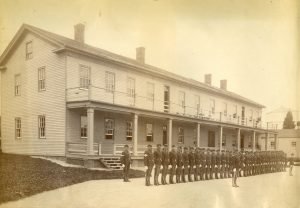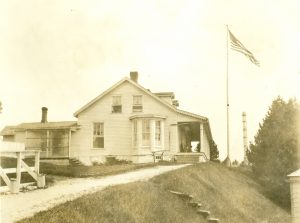
For a brief time, from April of 1882 until September of 1884, Fanny Dunbar Corbusier and her family lived at Fort Mackinac. She and her family thoroughly enjoyed their time on the island, which was already a tourist destination. While living on Mackinac Island, Fanny and her family took advantage of the island’s natural beauty and social scene to engage in activities familiar to modern visitors.
Fanny was born in 1838 in Baltimore, but also lived in Louisiana and Maryland as a child. She was an active part of her church, wherever she lived. Public service was important to her and she served as a nurse during the Civil War. At the age of 30 she met and married William Henry Corbusier, a military contract surgeon. He was one of many northern soldiers occupying Mobile, Alabama with the army after the war. Together, they enjoyed a 49 year-long marriage and raised five sons. The marriage plunged Fanny into the transient life of civilians attached to the army, moving from station to station as William was transferred to different posts.
At various times, Fanny and the family lived in Arizona, Nevada, New Mexico, the Philippines, the Dakota Territory, Wyoming Territory, Kansas, Colorado, Virginia, Indiana, California, New York, Nebraska, Alabama and of course Michigan. Their extensive travels were facilitated by regular long-distance train trips. The growing national railroad network allowed the army to move troops (and associated civilians like Fanny) quickly and easily around the country.
Within the small, close-knit army community, William’s position bestowed a level of social prestige upon Fanny. Officers and their families were generally quartered in larger, nicer homes, separate from the enlisted soldiers. Fanny had, and expected to have, servants to help her with cooking, laundry and other chores. She hired a nurse to assist with her first baby and at various times employed off-duty soldiers, Chinese workers, and Indigenous people to work in her household. Fanny hired a woman named Carrie Greatsinger to work as a nurse for the children before moving to Fort Mackinac.

Regardless of where she lived, Fanny took the education of her children seriously. As a child, she attended the Hannah More Academy in Maryland, where her mother was principal. While raising her own children, she made sure that they always had access to education. At Mackinac, her younger children attended classes in the Fort Mackinac reading room, where Sgt. Fred Grant and Pvt. Crawford Anderson served as teachers. In addition to school, while on Mackinac Island Fanny also “sent for all of the histories and romances of Mackinac that were ever published” and read with her family about Alexis St. Martin, Dr. William Beaumont, and John Tanner.
Fanny and William shared a lifelong interest in nature and spent time observing “the superb moonlight night” during their winters on Mackinac. In the fall they ”saw the island in its best array. The woods were gorgeous in the vari-colored trees and shrubbery, and then the aurora borealis in all its splendor would sometimes be seen.” Fall on Mackinac Island is still one of the most beautiful sights in Northern Michigan.
Fanny Dunbar Corbusier left Mackinac Island in 1884 after experiencing it in much the same way as countless others of the past and present. Her life only brought her back one more time in 1892. She visited with old friends and went for “lovely drives” to see what had changed. If you would like to learn more about the experiences of Fanny Corbusier and the other women who called Fort Mackinac home in the 18th and 19th centuries, check out our website for details on how to visit. Also consider joining Mackinac Associates, a friends group that makes it possible for us to interpret Fanny’s life as well as countless other facets of Mackinac’s rich history.









